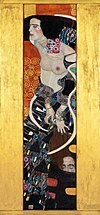Judith and Holofernes (Klimt)

|
| Judith I |
|---|
| Gustav Klimt , 1901 |
| Oil on canvas |
| 84 × 42 cm |
| Austrian Gallery Belvedere, Vienna |
Judith and Holofernes or Judith I is an oil painting by Gustav Klimt , which he painted in 1901. It shows the biblical person Judith holding the severed head of Holofernes .
Context and influences
When Klimt dealt with the subject, certain interpretations and representations had already developed in art. Many depictions focus on Judith's courage and virtue. Judith acts as God's tool, but the violence of the act cannot be denied. This is shown, for example, in the depictions of Michelangelo Merisi da Caravaggio , Artemisia Gentileschi and Trophime Bigot . Other representations, such as Moreau and Allori , have chosen the moment when Judith holds up Holofernes' head.
Klimt dispenses with any reference and concentrates on the visual representation of Judith. The head of Holofernes is only partially shown on the right edge. The painter renounces any reference to the bloody sword. The moment before the killing, the seduction of Nebuchadnezzar's general, seems to merge with the end of the story.
Judith I seems to have more parallels with the painting Die Sünde by Franz Stuck . The depiction of temptation becomes the model for Klimt's Femme fatale .
analysis

Judith's face exudes a mixture of lust and perversion . Her features are transfigured to reach the highest degree of seduction. Despite the changed facial features, Klimt's friend and possibly lover Adele Bloch-Bauer can be recognized, whom he had depicted in the pictures Adele Bloch-Bauer I (1907), Adele Bloch-Bauer II (1912) and earlier in Pallas Athena (1898) . The slightly raised head conveys pride, while her face is lazy and sensual and her open lips express defiance and seduction. Franz AJ Szabo describes the picture as a symbol of the victory of female eroticism over male aggression. In 1903 the author and critic Felix Salten describes Judith's portrayal in the picture as a sensual fire with a dark look and cruelty in the expression of her mouth and nostrils, which tremble with passion. Although Judith has been interpreted as a pious widow who did her duty, she is shown here as a femme fatale. The contrast between the dark hair and the golden background enhances the elegance. Her fashionable hairstyle is underlined by the surrounding trees. Her disheveled, transparent robe, which reveals her upper body, alludes to the fact that Judith beguiled General Holofernes before she beheaded him.
In the picture from 1901, Judith retains her fascination and sensuality, which she gives up in Judith II . There she has sharper features and a wild expression. In the first version, she revels in power and sexuality. Critics said it was Salome , the title character of Oscar Wilde 's tragedy of the same name . In response to this, Klimt had his brother Georg engrave a sign with the name "Judith and Holofernes" in the metal frame.
See also
Individual evidence
- ↑ Klimt also painted another painting called "Judith II"
- ↑ Compare Caravaggio's painting in Wiki Commons.
- ^ E. Di Stefano: Gustav Klimt , Art Dossier No. 29 (1988) passim . See pictures by Allori and Moreau on Wiki Commons.
- ↑ There are many associations with Salome . See Commons: "Salome" .
- ↑ Compare Federico Zeri, Giuditta I (1998), p. 4.
- ↑ Franz von Stuck also painted a Judith, but before she was killed. See Commons image .
- ^ Compare F. Zeri, Giuditta I, cit. , P. 8.
- ^ Compare Frank Whitford, Klimt (1990), sv "Adele Bloch-Bauer".
- ^ Compare F. Zeri, Giuditta I, cit. , Pp. 4-9.
- ^ Compare F. Zeri, Giuditta I, cit. , P. 8.
literature
- Zeri, Federico (1998), Giuditta I, Rizzoli (Italian)
- Kinsella, Eileen (January 2007), "Gold Rush", Artnews.
- Sabarsky, Serge (1983), Gustav Klimt: Drawings, et al., Moyer Bell.
- Whitford, Frank (1990), Klimt, Thames and Hudson.
Web links
- Gallery of works by Gustav Klimt at Zeno.org
- iKlimt.com
- Web Museum Klimt page
- Klimt movie in the Internet Movie Database (English)
- High resolution Klimt gallery
- Louis Gerber: Gustav Klimt. Retrieved September 22, 2018 .
